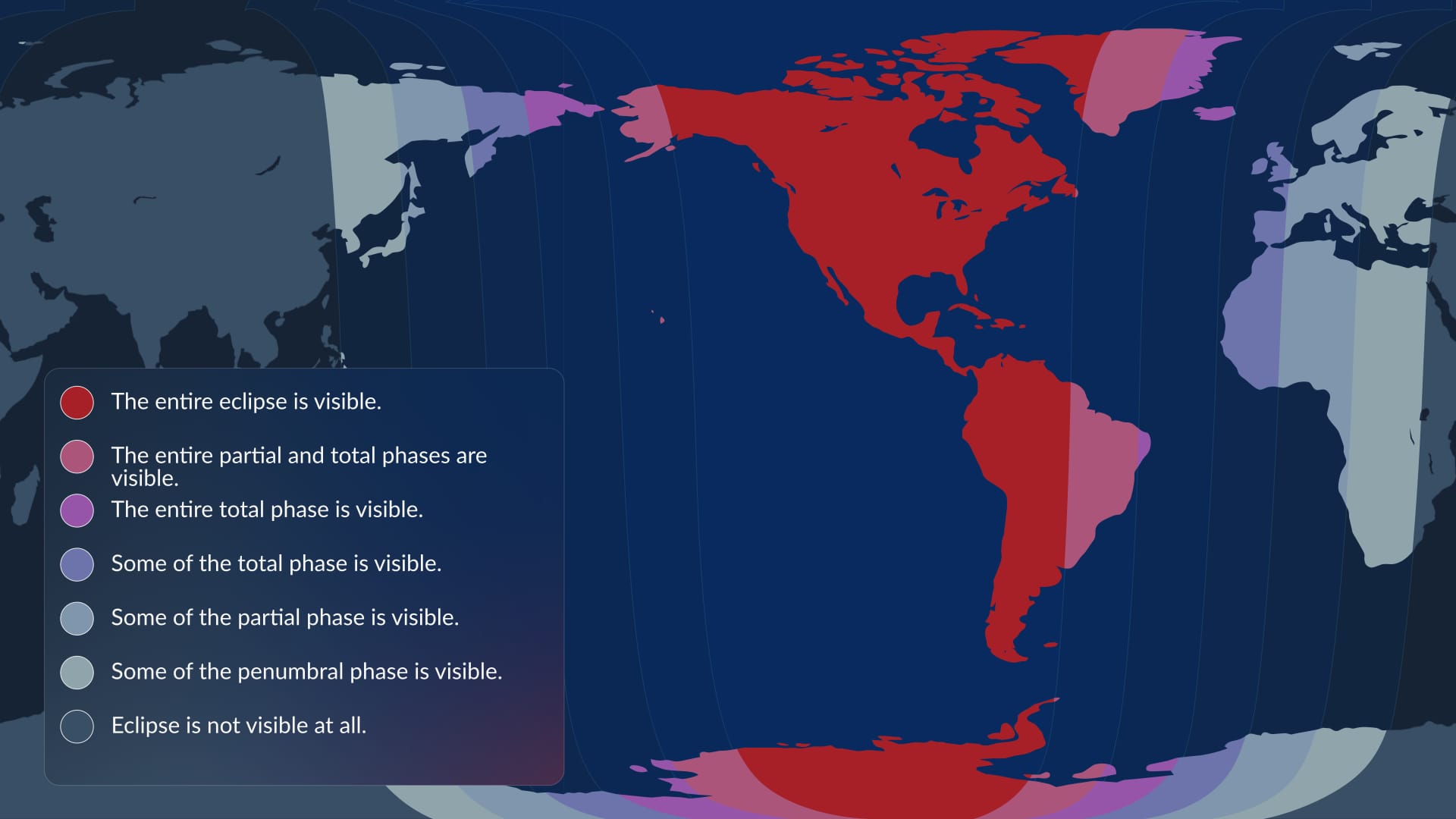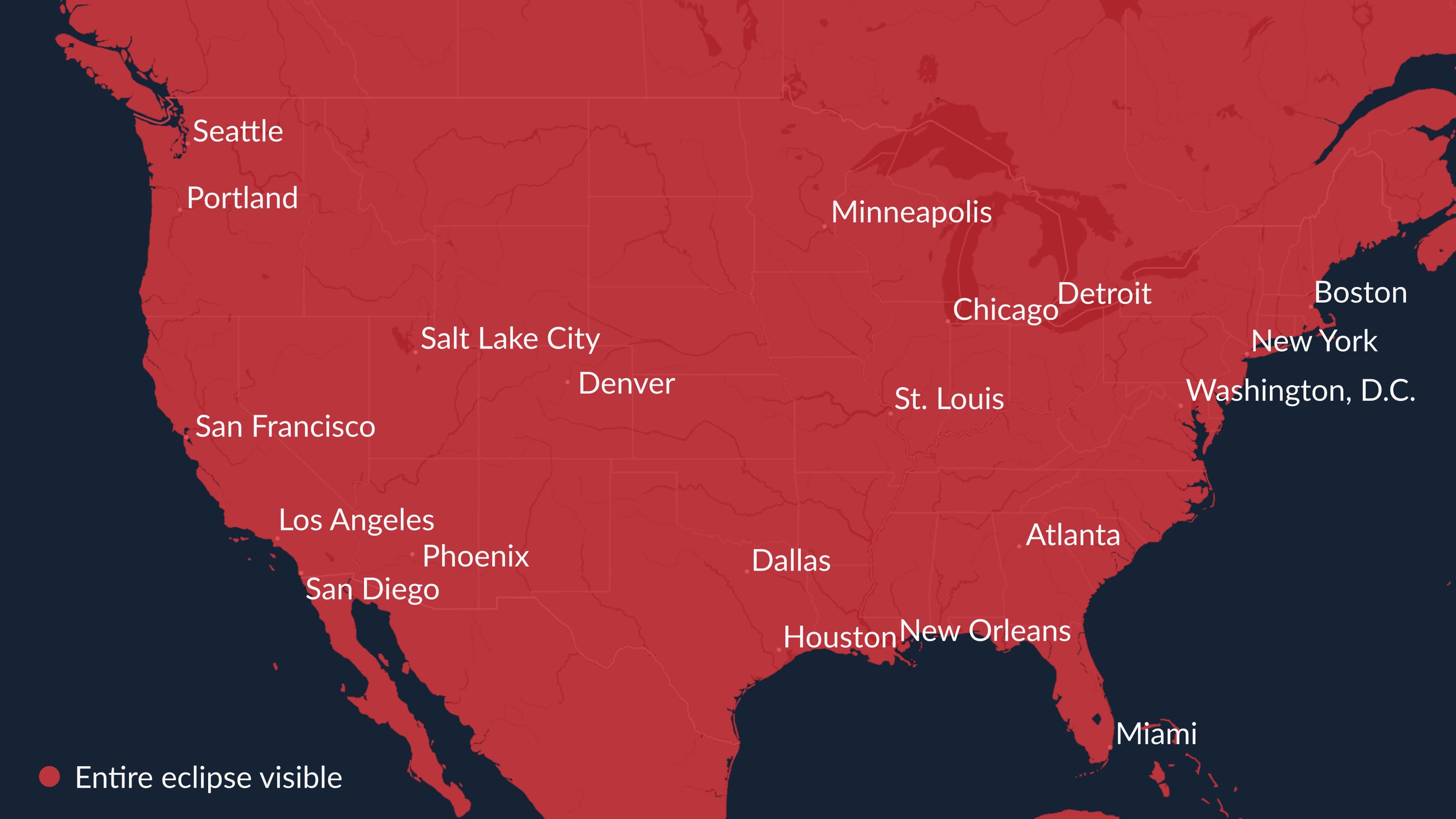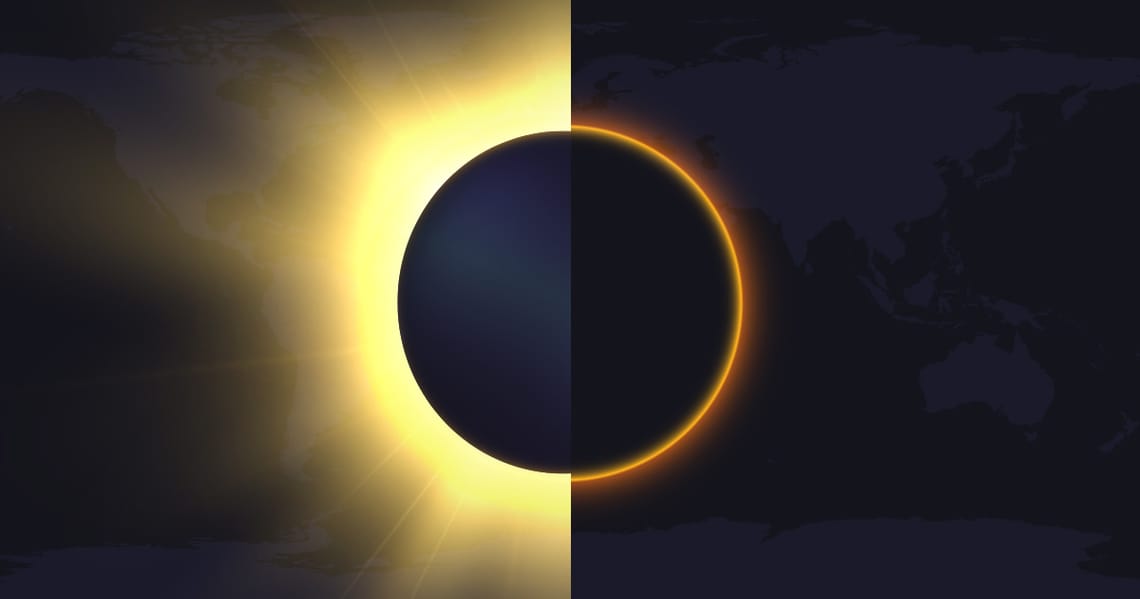Total Lunar Eclipse on March 13-14, 2025: Visibility Map and Timeline of the Blood Moon
Don’t miss the first total lunar eclipse in 2.5 years! On March 13-14, 2025, the Moon will turn red for 65 minutes! Visible across the U.S., Canada, and Mexico, no equipment needed! Check the exact timing for your location in the Sky Tonight app and read on to get the best viewing tips.
Contents
- Visibility map of the March 2025 lunar eclipse
- Time of the lunar eclipse in March 2025
- What will this lunar eclipse look like?
- When is the next lunar eclipse?
- March 2025 lunar eclipse: bottom line
Visibility map of the March 2025 lunar eclipse
The total phase of the March 13-14, 2025 lunar eclipse will last from 06:26 GMT to 07:32 GMT. If this timing falls during the night in your location, you'll be able to see the Blood Moon eclipse. Convert it to your local time to check if the total eclipse is visible from your location. Read on for the detailed eclipse schedule.
Some locations will see the entire total eclipse, while others will see only part of it, as the Moon rises later or sets earlier there:
- The entire eclipse will be visible over North and South America, western Europe, and western Africa.
- At least part of the eclipse will be visible from Europe, much of Asia, Australia, and Africa, all over North and South America, the Pacific, the Atlantic, the Arctic, and Antarctica.

Total lunar eclipse tonight: visibility map for the USA
The March 2025 lunar eclipse is a special event itself, but it's even more unique for people in the United States. This time, the "Blood Moon" phase — when the Moon turns a deep red — will be fully visible across the country. Don’t miss this rare event; it won’t happen again until 2048.
The best part about a lunar eclipse is that the Moon is visible even from light-polluted cities, such as New York, Los Angeles, Washington, D.C., and Miami. So you don’t have to worry about your location. Only clouds can stop you from enjoying the blood-red Moon!

Can I see the eclipse in my location?
To find out easily if the eclipse is visible from your location, use the free astronomy app Sky Tonight.
Type "lunar eclipse" in the search field, tap the matching result, and you'll see the visibility times for your location below the picture. If the event isn’t visible from where you live, you'll see a note below the "Global Visibility" times.
For a detailed visibility map, swipe the upper picture to the left (or tap the blue map icon in the picture’s upper-right corner). Zoom in on the map until you see your location. Tap the “i” button in the upper right corner to see what the colors of the map mean.

To see where the eclipsed Moon will be on the sky map, tap the target button. To match the image on your phone with the real sky, tap the compass button, then follow the white arrow until the Moon appears on your screen. Note its position and plan your viewing night in advance!

Time of the lunar eclipse in March 2025
This total lunar eclipse is perfect for night owls — it will happen in the dead of night!
The red line on the map below shows where the eclipse will peak around midnight on March 13-14 (the line marks the Moon on the meridian at greatest eclipse).

Here is the detailed schedule for the total lunar eclipse on March 13-14, 2025. The exact time depends on your time zone, so don't forget to convert the timeline to your local time. To understand what happens during each phase, check the next section of the article.
- Penumbral eclipse begins at 8:57 p.m. PDT, 11:57 p.m. EDT, 03:57 GMT;
- Partial eclipse begins at 10:09 p.m. PDT, 1:09 a.m. EDT, 05:09 GMT;
- Totality begins at 11:26 p.m. PDT, 2:26 a.m. EDT, 06:26 GMT;
- Maximum Eclipse is at 11:58 p.m. PDT, 2:58 a.m. EDT, 06:58 GMT;
- Totality ends at 12:31 a.m. PDT, 3:31 a.m. EDT, 07:31 GMT;
- Partial eclipse ends at 1:47 a.m. PDT, 4:47 a.m. EDT, 08:47 GMT;
- Penumbral eclipse ends at 3:00 a.m. PDT, 6:00 a.m. EDT, 10:00 GMT.
The entire eclipse will last 6 hours and 3 minutes, while the total phase (when the Moon is in Earth’s darkest shadow and appears dark red) will last only 1 hour and 5 minutes.

What happens during the total lunar eclipse?
-
Penumbral Eclipse Begins: The Moon enters Earth’s penumbra, the outer part of its shadow. The Moon starts to dim slightly, though the change is subtle and may be hard to notice.
-
Partial Eclipse Begins: The Moon begins to move into Earth’s umbra, the darker inner shadow. A noticeable "bite" appears to be taken out of the lunar disk as the umbra darkens part of the Moon.
-
Totality Begins: The entire Moon is now within Earth’s umbra. The Moon takes on a coppery red hue, often called a "Blood Moon." For a better view, use binoculars or a telescope. To photograph it, use a tripod and set your camera to exposures of several seconds.
-
Totality Ends: The Moon starts to leave the umbra, and the red tint fades. A "bite" reappears, but this time on the opposite side of the lunar disk.
-
Partial Eclipse Ends: The Moon fully exits the umbra and is once again only in the penumbra. The dimming effect is subtle and may be difficult to observe.
-
Penumbral Eclipse Ends: The Moon completely leaves Earth’s penumbra, marking the end of the eclipse.
What will this lunar eclipse look like?
During the total lunar eclipse in March 2025, the Moon will turn red — but not as dark as during some eclipses. That’s because it won’t pass through the deepest part of Earth’s shadow (the center of the inner circle in the image below). Instead, expect the Moon to take on a brighter red or coppery hue.
This eclipse will also feature a Micromoon, meaning the Moon will be slightly farther from Earth and will appear slightly smaller than usual — though the difference is so subtle, you might not even notice it!

What will the eclipse look like from my location?
Want to see how the eclipse will appear from where you are? Use the Eclipse Guide app! Its interactive maps let you preview the entire event — from start to finish — with the Moon’s orientation adjusted for your location.
The app also gives you exact eclipse times in your timezone, the best viewing spots, and more. You can even set alarms and notifications to make sure you don’t miss the big moment!
A series of four lunar and solar eclipses will occur in 2025. The March lunar eclipse is the first, followed two weeks later by a partial solar eclipse on March 29, 2025. Get the Eclipse Guide app now to prepare for them all!
When is the next lunar eclipse?
Missed the Blood Moon in March 2025? Don’t worry — another total lunar eclipse is coming soon!
On the night of September 7-8, 2025, the Moon will once again pass through the darkest part of Earth's shadow, turning red for 1 hour and 22 minutes. This eclipse will be visible from Europe, Russia, Asia, Australia, Africa, and Antarctica.
For details on more upcoming eclipses, check out our regularly updated infographic!

March 2025 lunar eclipse: bottom line
The first total lunar eclipse in 2.5 years will occur on the night of March 13-14, 2025. If you live in North or South America, western Europe, or western Africa, you’ll get to see the Moon turn red! It’s been a long wait for this eclipse, so let’s hope for clear skies. To check the eclipse schedule and see exactly where the Moon will be in your sky, use the free Sky Tonight app.
While you wait, why not test your knowledge of solar and lunar eclipses with our fun quiz?

